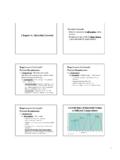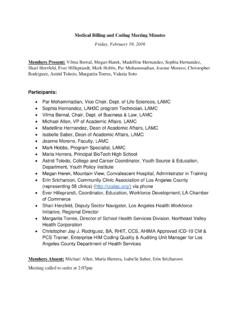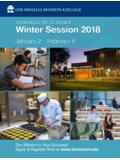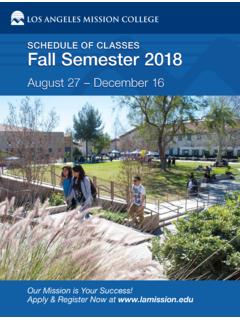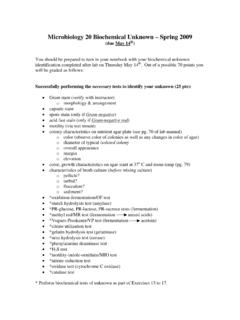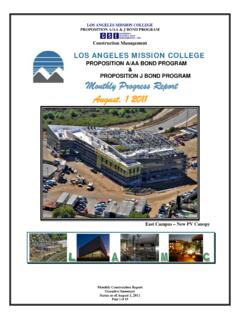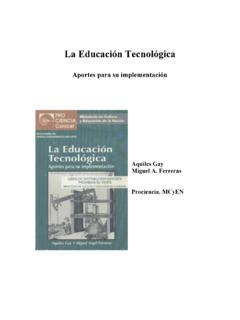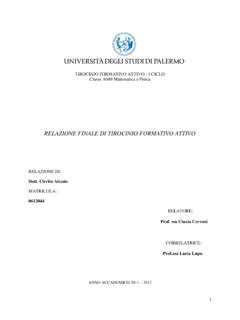Transcription of LAB 3 Use of the Microscope - Los Angeles Mission College
1 37 LAB 3 Use of the Microscope Introduction In this laboratory you will be learning how to use one of the most important tools in biology the compound light Microscope to view a variety of specimens. You will also use a slightly different type of light Microscope called a stereoscopic dissecting Microscope . The first lens used to magnify things was developed in the first century These were pieces of glass shaped in a convex form thicker in the middle and tapering off to the sides and were the first magnifying glasses that could increase the image of an object about 10 20 X. The creation of glass lenses improved dramatically at the end of the 16th century, vastly improving the magnifying power.
2 By 1609, galileo galilei refined the methods of lens making in an effort to view objects in the sky. About half a century later, the Dutchman Anton van Leeuwenhoek further improved the art of lens making, allowing him to view objects in pond water that had never been viewed by humans microorganisms life at a tiny level. At the same time, an English physicist named Robert Hooke improved the technology of van Leeuwenhoek and confirmed the existence of tiny organisms in pond water. He also famously examined a piece of cork and observed tiny boxes arranged in such a way that they looked like the cells (rooms) in a monastery if you removed the roof and looked in from above.
3 Today the best compound light microscopes are able to magnify objects up to 2,500X without losing their resolution the sharpness of the image itself. Part 1: THE COMPOUND LIGHT Microscope The Parts of the Compound Light Microscope *Exercise 1A Getting familiar with the Microscope You will first get acquainted with the major parts of the compound light Microscope before learning the proper way to use it. Get a Microscope from the cabinet below your lab bench, being sure to handle it by the arm and base (refer to image on page 2), and place it on the bench in front of you. Remove the cover and place it below, out of the way, and then plug in the Microscope . The ocular lens (eyepiece) and stage should be facing you.
4 Read the description of each part of your Microscope on the next two pages being sure to follow all instructions, and then complete the matching exercise on your worksheet. 38 OCULAR LENS (eyepiece) Your Microscope will have either one (monocular) or two (binocular) ocular lenses. These are the lenses you will look through when examining a specimen with the Microscope . Take a look at the side of your ocular lens and you will notice a label of 10X . This indicates that each ocular lens magnifies the image by a factor of 10 or 10X. OBJECTIVE LENSES Notice the set of objective lenses on the revolving nosepiece. These lenses allow you to change the degree of magnification.
5 Some of our microscopes have four objective lenses while others have only three. The degree of magnification for each objective lens is indicated on its side. Let s take a look at each progressing from the shortest to longest objective lenses, being sure to rotate the revolving nosepiece to click each objective lens into position above the stage before examining it: 4X This objective magnifies the image by a factor of 4. It is referred to as the scanning objective since it is used to scan the slide to locate the specimen before viewing it at higher magnification. Your Microscope may not have this objective lens, in which case you can begin with the 10X objective.
6 10X This objective magnifies the image by a factor of 10 and is referred to as the low power objective. 43X (or 45X) This objective magnifies the image by a factor of 43 (or 45) and is referred to as the high power objective. 100X This objective magnifies the image by a factor of 100. It is referred to as the oil immersion objective since it requires a drop of immersion oil on the slide to provide good resolution. You will not be using this objective lens. For now, make sure that the low power objective is clicked into position above the stage, and keep in mind that you will only be using the low power and high power objectives. Also keep in mind that the total magnification of any image you see through the ocular lens is the product of the objective and ocular lens magnifications (for example, when using the lower power lens the total magnification is: 10X ocular x 10X low power objective = 100X).
7 39 STAGE and STAGE CLIP The stage is the flat surface upon which you will place each slide you will examine. Notice that there is a moveable stage clip that can be used to secure the slide on the stage. Open and close the stage clip to see how it will snugly hold your slide in position. MECHANICAL STAGE KNOBS To move the slide on the stage when it is secured in the stage clip, you will use the mechanical stage knobs on the underside of the stage to move the slide backward/forward and right/left. Adjust each knob to see how one knob controls backward/forward movement and the other knob controls right/left movement. COARSE FOCUS and FINE FOCUS KNOBS In order for a specimen on a slide to be in focus, the distance between the specimen and the objective lens must be just right.
8 The coarse focus knob, the larger of the two, will move the stage or objective lens (depending on the Microscope ) up and down quickly and quite visibly, altering the distance between them. It is very important that the coarse focus knob is only used with the low power or scanning objective lenses, otherwise the Microscope or objective lenses could be damaged. Adjust the coarse focus knob to observe how quickly the focal distance changes. In contrast, the fine focus knob will move the stage or objective lens such a small amount that it is hardly noticeable to the naked eye. This is the knob you will use to get the perfect focal distance so the image will be crystal clear.
9 CONDENSER LENS Just underneath the stage is the condenser lens. This lens serves to capture and focus light from the lamp below onto the slide mounted on the stage. On many microscopes the condenser lens can be adjusted up or down with a knob beneath the stage. Examine the condenser on your Microscope to see if it is adjustable. If so, be sure to adjust it as high (close to the stage) as possible since, for our purposes, this is where it should be set. DIAPHRAGM The diaphragm is located within the condenser and is one of the most important pieces of the Microscope , though it is often neglected by many students. The diaphragm allows you to adjust the amount of light passing through the slide by adjusting the diaphragm lever.
10 Most of the time the diaphragm will be all the way open to allow the maximum passage of light. However it is important to adjust the diaphragm at times to reduce the amount of light passing through your specimen should the image be too bright or dim, and also to increase the contrast to allow you to see the specimen more easily against the background. For now, open the diaphragm all the way, and when using the Microscope , do not forget to use the diaphragm. LAMP The lamp emits light to illuminate the specimen so that you can actually see something. BASE and ARM The base is the bottom of the Microscope that sits on the table, and the arm is the vertical framework ascending from the base along the back of the Microscope .
